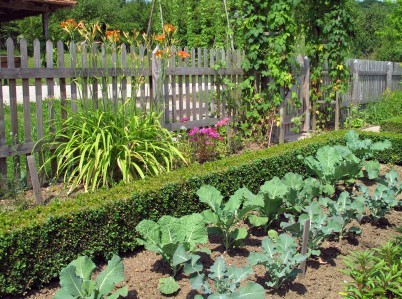After planting your vegetable garden, it might seem like there's a lot of downtime while waiting for your crops to grow. Actually, this is an important time for establishing a routine for garden maintenance. This regular care is vitally important if you want to reap a good harvest later in the season.
Most garden vegetables need about 1 inch of water each week during the growing season. Because Mother Nature rarely provides 1-inch rainfalls with consistent regularity, you're going to have to help her out with some supplemental watering.
Priority should be given to seedlings and transplants, but supplemental watering is also important during other critical phases of your crop's development. For example, tomatoes and melons will need plenty of water early in the season when their foliage and fruit are in the early stages of development.
As fruit ripens you can back off on the watering as slightly drier conditions actually help produce higher quality fruit. Lettuce, cabbage, and other leafy greens are exactly the opposite. They will require more and more water as they mature.
While flowering:
While fruiting:
All of the time:
Managing weeds should be part of garden maintenance from the beginning to end of the growing season. Any weeds growing within 12 inches of your vegetable plants are in direct competition for water and nutrients and should be removed.
Once the soil has sufficiently warmed up and your seedlings appear sturdy, apply a few inches of mulch around the base of your plants to suppress weeds and help reduce moisture loss. A double mulch of newspapers followed with a layer of organic material such as straw, or grass clippings will significantly reduce your need to battle weeds.
As leafy greens emerge, as well as root vegetables like carrots, beets and radishes, thin them to their proper spacing by snipping extras off at soil level with a scissors.
Plants that produce heavy fruits (or prolific amounts of fruit) need stakes, cages, or trellises to keep their fruits supported and off the ground and protected from disease. Add supports in the early stages of development so you can redirect stems as necessary as the plants grow to keep fruits easily accessible for harvesting.
As pumpkins, melons, and winter squash mature, slip pieces of board or shingles under them keep them clean and dry. You can also use old t-shirts, panty hose, or netting to make slings that support individual fruits.
Vegetables that mature slowly (take 50 days or more to reach maturity) often benefit from a boost of fertilizer about midsummer. Tomatoes, peppers, beans, and corn should be fertilized just as they reach their reproductive stage of growth. To do this, pull back the mulch and spread a 1/2 inch layer of compost or well-rotted manure over the soil, water, and replace the mulch. Vegetables grown in containers should be given a liquid fertilizer (such as manure tea) every two or three weeks throughout the season.
Many vegetables are pollinated with the help of pollen transporters like honeybees and other insects. For squash, cucumbers, and melons, the presence of insect pollinators is crucial. To help lure pollinators to your garden, plant a few clumps (or arrange a few pots) of native flowers near these crops (bees are much more attracted to natives than "exotics").
Bees tend to find white, blue, purple, yellow and violet flower most attractive. Avoid using pesticides in the garden, which can harm pollinators like bees as well as a host of other beneficial insects.
Make a habit of checking for signs of problems and dealing with them before get out of hand. Walk through your garden daily - or at least every other day-to pull weeds, check for pests and look for signs of disease. Catching problems early allows you to correct the situation before it gets out of control.

About The Author: Ellen Brown is an environmental writer and photographer and the owner of Sustainable Media, an environmental media company that specializes in helping businesses and organizations promote eco-friendly products and services.
Add your voice! Click below to comment. ThriftyFun is powered by your wisdom!